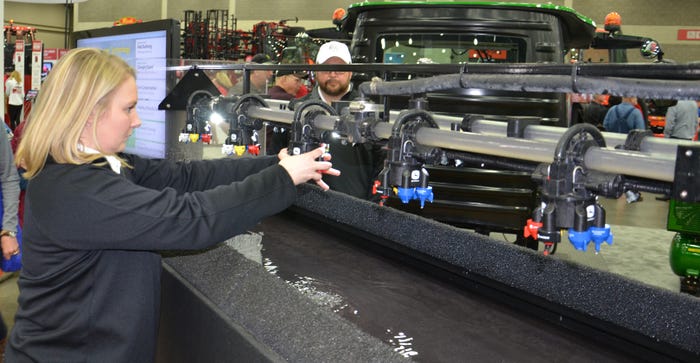
Cutting-edge technology that detects weeds and sprays then and only then may be coming, but it’s not available yet. In the meantime, you can go as far as your imagination, your understanding of technology and your checkbook will allow in fine-tuning how precise you get with spray applications.
Every company that makes a sprayer is offering its own version of precision technology to improve spraying accuracy. Here is a look at John Deere’s approach, ExactApply, through a slideshow of photos from a demonstration with a mock sprayer setup.
John Deere announced in 2016 that ExactApply was coming on 2018 sprayers. The new models arrived, and sure enough, they are equipped to do things John Deere sprayers couldn’t do before in terms of adjustments on the go to improve accuracy. Just recently, the company announced ExactApply technology is available to retrofit its 4 Series sprayers made in or after 2014.
Dynamic demos
Lindsay Pollock of John Deere operated the mock sprayer setup, complete with controller, boom and nozzle bodies. Each body was equipped with multiple nozzles and was capable of pulse width modulation technology, which allows individual control, nozzle by nozzle, from the cab.
Here’s a look at some of ExactApply’s features:
• Auto select. With the system set in this option, nozzles spray without the pulse width modulation system. Certain herbicides, including the newest dicamba herbicides that can be applied over dicamba-tolerant soybeans, don’t have PWM nozzles on their labels. ExactApply from John Deere allows you to spray with or without PWM operating, Pollock says.
• Switch nozzles. There may be situations where you need to switch from one nozzle type to another. You can do it with the push of a button with ExactApply, Pollock says. Here’s how it works. You preselect a nozzle and designate it as A, and designate a second nozzle as B. Then you can switch back and forth between those two nozzles. You can also allow both nozzles to spray at the same time.
• Turn compensation. Using the PWM technology, you can deliver the same amount of material through each nozzle during a turn. Without turn compensation, more material is typically applied by nozzles closer to the center of the sprayer because they travel a much shorter distance during a turn.
• Section control. Sprayers with section control can signal banks of nozzles to shut off as they cross a waterway if it’s programmed into the prescription for the field. With ExactApply and nozzle-by-nozzle control, individual nozzles can shut off as they reach the waterway, keeping more of the waterway intact while spraying all areas not in the waterway.
• Coverage without streaks. By using 15 and 30 hertz in the PWM system, there is less tendency to streak than in systems operating at 10 and 15 hertz, Pollock says. That’s simply because the higher frequency allows for better coverage, she adds.
About the Author(s)
You May Also Like




